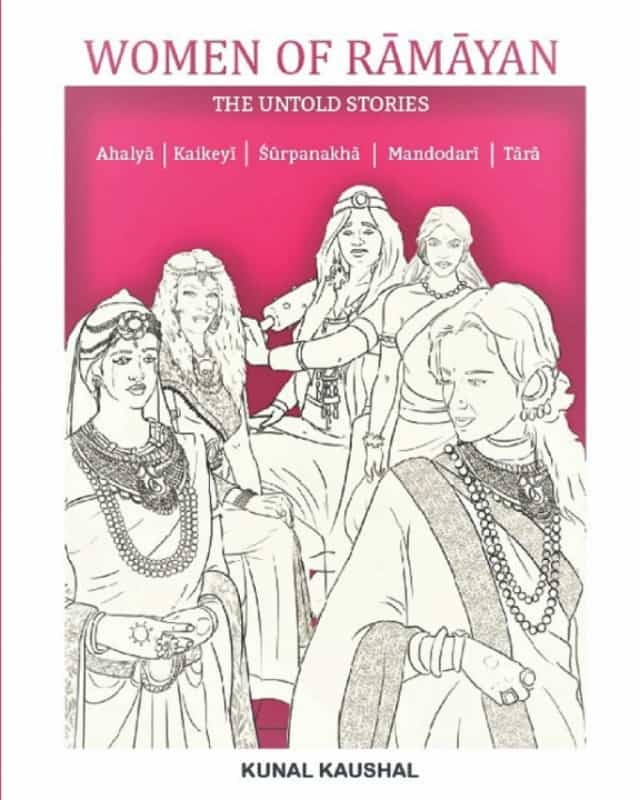Plot: 4/5
Characters: 4/5
Writing Style: 4/5
Climax: 4/5
Entertainment Quotient: 4/5
Enthralling and startling at the same time, this book provides a reading against the grain of the events of the Ramayana through five women characters namely Ahalya, Kaikeyi, Surpnakha, Mandodari, and Tara. The book opens with a set of six hypotheses based on the torments that these women had to go through.
After this is followed a map of geographical regions that were a part of ancient Indian civilization. Though the map is hand-drawn, it is legible and clear. It familiarises the readers with the geographical regions and terminology that will be further used in the book for example Devlok stands for the landmass that is comprised of mountain ranges and foothills of the Himalayas and the country refers to Jambudvip. Similarly, it also provides a list of the different communities that were living at that time.
The book is highly organized and thoughts pan out well in a leveled manner. Though surprising at times, the ideas will seem interesting even to a reader who may begin with some skepticism. These ideas are interspersed with illustrations that make the book engaging even for young readers though it is suitable for ages 10 and above. However, like the book cover, the illustrations are also colourless. The appendix at the end with Devanagiri transliteration and a glossary of terms is definitely useful.
The language is easy to follow. The arguments are highly convincing. The stories of each of these five women are retold from their perspectives. The dialogues show their fiery zest at being wronged. These women are given a voice that retells their stories from a new angle which is oft thought of but seldom put into words and all of it is present under one roof in a single book. The narratives of the tales are moderately paced, well organized, and have multiple climaxes.
In trying to contextualize these female characters, the book does not meddle with either history or mythology but rather puts them into proper perspective and helps visualize the moral takeaways through these representations. The tales are of moderate length though not too short. It is their newness that calls for soaking in the ideas by sparing enough time. Hence, this is not a book that can be read in haste. The tales definitely simply a lot of things while also raising some pertinent questions.
Nonetheless, the book does not attempt to answer any of them or provide any groundbreaking solutions. It leaves that to the readers and is open for interpretation and discussion which makes the book highly creative.
The climax acts in an uncluttered manner. There are no circumlocutory or parenthetical digressions. The argument is already mentioned at the beginning of the tale. What is of interest is the manner in which these arguments unfold through the voice of these female characters. It does not sympathize with these characters neither does it pity them. It unfalteringly showcases their strength and intelligence to withstand difficulties that make them so inspiring.
This book is innovative in the sense that it comes up with very new standpoints from the perspective of these female characters which the author hopes will be given a thought by readers. These theories are based on rational thinking and deep textual analysis.
Armed with a critical understanding of history, this book presents some of the strongest women of Hindu mythology to be read as strong women of history. It does an amazing job in bringing out their mettle, stamina, and caring side through a rational yet sensitive lens.
As a student of Indian history, Kunal Kaushal believes that mythology is simply an extension of history into times that we are not completely certain about. This book is his unique take on five of the women mythological characters from the Ramayana to uncover the distant past that is shrouded in layers of fantastical elements. However, this book can serve as a prelude to reading the Ramayana but not necessarily a handbook to the incidents and events of the Ramayana. Hence, it provides an alternate reading to this ancient text from a feminist perspective.
This is all an attempt to make the layers pass the believability test as Kaushal states in the preface to writing this book. It is his effort to reach the core of the Ramayana and in doing so to pass on the morals and values that the Ramayana exudes which has made it stand the test of time. It is also almost a tribute to these five women characters who stand as epitomes of strength and courage. This book will particularly be of interest to students of history, lovers of Hindu mythology, and readers who enjoy women-centric books.
Can’t wait to read it? Buy your copy of “The Women OF Ramayana” using the link below
